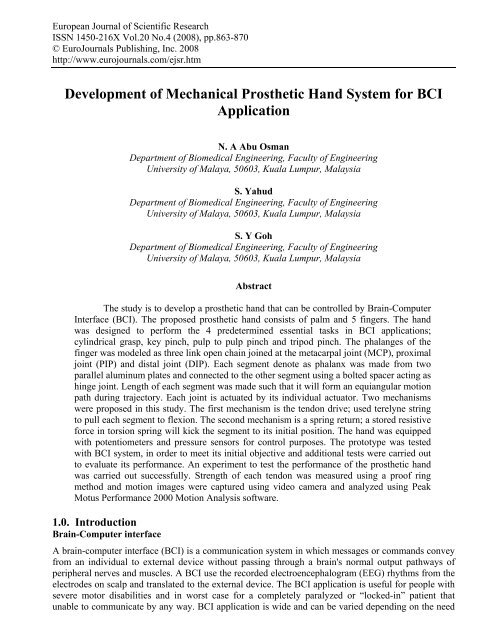European Journal of Scientific Research - EuroJournals
European Journal of Scientific Research - EuroJournals
European Journal of Scientific Research - EuroJournals
Create successful ePaper yourself
Turn your PDF publications into a flip-book with our unique Google optimized e-Paper software.
<strong>European</strong> <strong>Journal</strong> <strong>of</strong> <strong>Scientific</strong> <strong>Research</strong><br />
ISSN 1450-216X Vol.20 No.4 (2008), pp.863-870<br />
© Euro<strong>Journal</strong>s Publishing, Inc. 2008<br />
http://www.eurojournals.com/ejsr.htm<br />
Development <strong>of</strong> Mechanical Prosthetic Hand System for BCI<br />
Application<br />
N. A Abu Osman<br />
Department <strong>of</strong> Biomedical Engineering, Faculty <strong>of</strong> Engineering<br />
University <strong>of</strong> Malaya, 50603, Kuala Lumpur, Malaysia<br />
S. Yahud<br />
Department <strong>of</strong> Biomedical Engineering, Faculty <strong>of</strong> Engineering<br />
University <strong>of</strong> Malaya, 50603, Kuala Lumpur, Malaysia<br />
S. Y Goh<br />
Department <strong>of</strong> Biomedical Engineering, Faculty <strong>of</strong> Engineering<br />
University <strong>of</strong> Malaya, 50603, Kuala Lumpur, Malaysia<br />
Abstract<br />
The study is to develop a prosthetic hand that can be controlled by Brain-Computer<br />
Interface (BCI). The proposed prosthetic hand consists <strong>of</strong> palm and 5 fingers. The hand<br />
was designed to perform the 4 predetermined essential tasks in BCI applications;<br />
cylindrical grasp, key pinch, pulp to pulp pinch and tripod pinch. The phalanges <strong>of</strong> the<br />
finger was modeled as three link open chain joined at the metacarpal joint (MCP), proximal<br />
joint (PIP) and distal joint (DIP). Each segment denote as phalanx was made from two<br />
parallel aluminum plates and connected to the other segment using a bolted spacer acting as<br />
hinge joint. Length <strong>of</strong> each segment was made such that it will form an equiangular motion<br />
path during trajectory. Each joint is actuated by its individual actuator. Two mechanisms<br />
were proposed in this study. The first mechanism is the tendon drive; used terelyne string<br />
to pull each segment to flexion. The second mechanism is a spring return; a stored resistive<br />
force in torsion spring will kick the segment to its initial position. The hand was equipped<br />
with potentiometers and pressure sensors for control purposes. The prototype was tested<br />
with BCI system, in order to meet its initial objective and additional tests were carried out<br />
to evaluate its performance. An experiment to test the performance <strong>of</strong> the prosthetic hand<br />
was carried out successfully. Strength <strong>of</strong> each tendon was measured using a pro<strong>of</strong> ring<br />
method and motion images were captured using video camera and analyzed using Peak<br />
Motus Performance 2000 Motion Analysis s<strong>of</strong>tware.<br />
1.0. Introduction<br />
Brain-Computer interface<br />
A brain-computer interface (BCI) is a communication system in which messages or commands convey<br />
from an individual to external device without passing through a brain's normal output pathways <strong>of</strong><br />
peripheral nerves and muscles. A BCI use the recorded electroencephalogram (EEG) rhythms from the<br />
electrodes on scalp and translated to the external device. The BCI application is useful for people with<br />
severe motor disabilities and in worst case for a completely paralyzed or “locked-in” patient that<br />
unable to communicate by any way. BCI application is wide and can be varied depending on the need

















